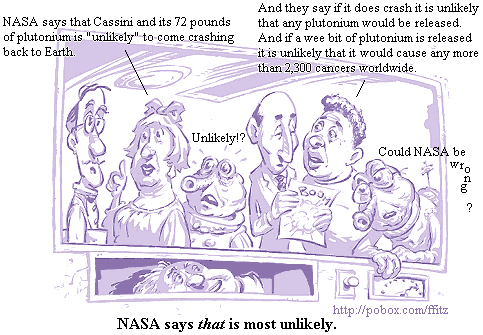
On October 6, 1997, In October, 1997 NASA launched from the Cape
Canaveral Air Force Station in Florida the Cassini space probe with 72.3 pounds of deadly
plutonium on-board. The probe will use the plutonium to power electrical instruments
during its voyage to the planet Saturn. As Dr. Helen Caldicott, founder of
Physicians for Social Responsibility, states - plutonium "is so toxic that less than
one-millionth of a gram, an invisible particle, is a carcinogenic dose. One pound,
if uniformly distributed, could hypothetically induce lung cancer in every person on
Earth."
Yet NASA would load 72.3 pounds of plutonium -- the most that has ever
been used on a space device -- on the Cassini mission.
How could the plutonium be released and kill people?
There are two key periods of extreme danger:
| 1. The Cassini probe was taken into space on a Titan IV rocket.
If this rocket exploded on the launch pad or in the atmosphere -- as the space shuttle
Challenger did in 1986 -- then it is possible that the lethal plutonium could have spread
across wide areas of Florida. 2. The Cassini's propulsion source
doesn't have the power to send it straight to Saturn. NASA plans to send it to Venus
first, and then, after two swings around Venus, have Cassini and its plutonium hurtle
right back toward Earth. The idea is to use the Earth's gravity to increase
Cassini's velocity so that it can pass by Jupiter and then go to Saturn. Cassini is
to pass just 312 miles above Earth in what NASA calls a "slingshot maneuver" or
"flyby". But too deep a descent could cause Cassini to disintegrate in the
Earth's 75-mile-high atmosphere. Then, according to City University of New York
nuclear physics professor Dr. Michio Kaku, the plutonium -- "the most toxic chemical
known to science" -- would "shower down with a tremendous tragedy for the people
of the Earth." |
NASA's Record of Failure
NASA claims that the plutonium on board the Cassini probe has almost no chance of
contaminating the Earth. However, the Titan IV rocket is the same kind of rocket that on
August 2, 1993 exploded over the Pacific Ocean, destroying its payload containing a $1
billion U.S. spy satellite system. Indeed, three of the 24 known U.S. space missions
involving nuclear power have met with accidents, as well as six out of the 39 Russian
missions. Space missions are clearly not as safe as NASA would like the public to believe.
John Pike, head of space policy at the Federation of American Scientists, estimates the
odds for failure of a Titan IV rocket are "between one in ten and one in
twenty." We can be grateful that this launch was successful, but
if NASA has its way there will be many more launches of nuclear material. Where will you
be when NASA's luck runs out?
| ... the odds for failure of a Titan IV rocket are
between 1 in 10 and 1 in 20 |
The above information was excerpted from one of many
pages concerning the Cassini launch that can be found on the Florida Coalition for Peace
and Justice website at http://www.afn.org/~fcpj/space/cassini/index.htm
It is the position of many experts that there are far less dangerous methods that could be
used for this mission. Check out the FCPJ site for additional information.
The official NASA Cassini site at http://www.jpl.nasa.gov/cassini/ tries hard to
convince us nervous nellies that everything is A-OK , thank you. Be sure to check
out their Nuclear Safety section if you have a fondness for the word "unlikely."
There I ran into the old "extremely unlikely sequence of events" which, to
my knowledge, first came into popular usage during the Three Mile Island funfest.
Some things never go out of fashion.
The STOP CASSINI WEB SITE at http://www.animatedsoftware.com/cassini/cassini.htm
is thorough and has links to many articles on the subject of nukes in space. Check
out the link to Professor Karl Grossman's new book, The Wrong Stuff, and the one to
"FALSE, TRUE... and TRUER," which is a rebuttal to the NASA "False,
True" page, which is a rebuttal to the folks who think Saturn isn't going anywhere
and maybe we should slow down a think this thing over a bit.
EnviroVideo at http://home.earthlink.net/~envirovideo/
produces environmental videos on nukes in space (including Cassini), Three Mile Island,
Chernobyl, nuclear waste, renewable energy (solar, wind, hydrogen), food irradiation,
cancer, pollution, environmental racism and more.
You can also visit another Stop Cassini Web Site at http://www.lovearth.org
The site looks like it was designed by some folks who should trim their coffee intake, but
it offers many suggestions on possible actions and links to related sites. Some of
the recommendations:
| 1. Call/Fax President Clinton at the White House:
(Phone) 202 - 456 - 1414, (Fax) 202 - 456 - 2461. These numbers are available 24
hours a day, 7 days a week. 2. Call the Senate and Congress
for free at 888 - 723 - 5246. (Representatives Lynn Woolsey, Ron Dellums,
Bernie Sanders and Pete Stark are against the Cassini Mission. What about your
Representatives?) |
You are encouraged to Save and display this page on your
website, if you have one. The cartoon above is 30KB. There is a larger version (44KB) with slightly different caption also available.
| . And 50 years
into the future, the Spacebusters are still looking
longingly at Saturn, which is rumored to be out there somewhere (probably).
. |
Adnob Menu
ffitz images &
design About the
Artist Main Menu Home
Contact |
